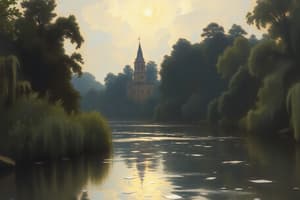Podcast
Questions and Answers
Which of the following is NOT considered an element of art?
Which of the following is NOT considered an element of art?
- Shape
- Perspective (correct)
- Color
- Texture
The principles of art refer to the basic components used to create art objects.
The principles of art refer to the basic components used to create art objects.
False (B)
Name two elements of art that can be used to express ideas.
Name two elements of art that can be used to express ideas.
Color, Texture
The ___ principle refers to the visual weight and stability of an artwork.
The ___ principle refers to the visual weight and stability of an artwork.
Match the following elements of art to their definitions:
Match the following elements of art to their definitions:
Which of the following is an example of a principle of art?
Which of the following is an example of a principle of art?
Artists select their media based on the elements of art they intend to use.
Artists select their media based on the elements of art they intend to use.
What role do principles of art play in artistic expression?
What role do principles of art play in artistic expression?
Which of these elements is NOT mentioned as a component of art?
Which of these elements is NOT mentioned as a component of art?
Artists always make deliberate decisions regarding the principles of art.
Artists always make deliberate decisions regarding the principles of art.
Which term describes the effect when different hues are used to add interest to a composition?
Which term describes the effect when different hues are used to add interest to a composition?
Name three elements of art that artists might instinctively select and organize in their works.
Name three elements of art that artists might instinctively select and organize in their works.
The use of ___ in a painting can indicate the form and structure of an object.
The use of ___ in a painting can indicate the form and structure of an object.
Harmony in a work of art can only be achieved through contrasting hues.
Harmony in a work of art can only be achieved through contrasting hues.
What type of artists might use art elements more spontaneously?
What type of artists might use art elements more spontaneously?
What principle of art is primarily used to lead a viewer to sense action in a work?
What principle of art is primarily used to lead a viewer to sense action in a work?
The three types of balance in art are __________, __________, and __________.
The three types of balance in art are __________, __________, and __________.
Match the following art components with their descriptions:
Match the following art components with their descriptions:
Most people focus only on the subject matter when examining a work of art.
Most people focus only on the subject matter when examining a work of art.
Match the type of balance with its description:
Match the type of balance with its description:
Describe what a 'three-dimensional form' in art means.
Describe what a 'three-dimensional form' in art means.
What does the term 'hue' refer to in the context of art?
What does the term 'hue' refer to in the context of art?
Using primary colors in art can effectively help in expressing thoughts and feelings.
Using primary colors in art can effectively help in expressing thoughts and feelings.
How can an artist create a work that expresses a specific mood through color?
How can an artist create a work that expresses a specific mood through color?
Study Notes
Understanding Art's Language
- Art utilizes its own visual language, comprised of elements and principles.
Elements of Art
- Color: A fundamental component of art, it conveys feelings, ideas and thoughts.
- Value: Relates to the lightness or darkness of a color.
- Line: A mark made on a surface, it can be straight, curved, thick, thin, etc.
- Texture: Refers to the surface quality of an object, how it feels or appears to feel.
- Shape: A two-dimensional area enclosed by a line or outline.
- Form: A three-dimensional object with height, width, and depth.
- Space: The area around and between objects, both positive and negative.
Principles of Art
- Balance: The distribution of visual weight in a composition.
- Emphasis: Drawing attention to a specific part of a work.
- Harmony: Creating a sense of unity through consistency in elements.
- Variety: Using differences in elements to create visual interest.
- Gradation: A gradual change in value, color, or size.
- Movement: Guiding the viewer’s eye through the composition.
- Rhythm: Repetition of elements to create a sense of pattern or flow.
- Proportion: The relative size of objects within a work.
Analyzing Art
- Understanding the elements and principles of art allows viewers to analyze and appreciate a work on a deeper level.
- By examining each element in a work, viewers can identify how the artist has organized and applied these principles to create a unified whole.
- This analysis extends beyond simply recognizing the subject matter and delves into the artistic decisions made by the creator.
- The elements of art are the "building blocks" and the principles are the "rules" or "guidelines" that artists use to create their作品.
Studying That Suits You
Use AI to generate personalized quizzes and flashcards to suit your learning preferences.
Related Documents
Description
Explore the fundamental elements and principles of art in this informative quiz. Learn how color, value, line, and texture contribute to the visual language of art, as well as how balance, emphasis, and harmony create compelling compositions. Test your knowledge and understanding of these essential concepts in art.




